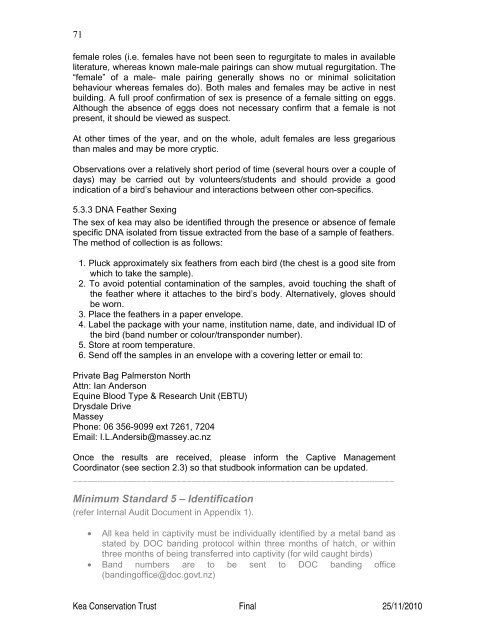(Nestor notabilis) Husbandry Manual - Kea Conservation Trust
(Nestor notabilis) Husbandry Manual - Kea Conservation Trust
(Nestor notabilis) Husbandry Manual - Kea Conservation Trust
Create successful ePaper yourself
Turn your PDF publications into a flip-book with our unique Google optimized e-Paper software.
71<br />
female roles (i.e. females have not been seen to regurgitate to males in available<br />
literature, whereas known male-male pairings can show mutual regurgitation. The<br />
“female” of a male- male pairing generally shows no or minimal solicitation<br />
behaviour whereas females do). Both males and females may be active in nest<br />
building. A full proof confirmation of sex is presence of a female sitting on eggs.<br />
Although the absence of eggs does not necessary confirm that a female is not<br />
present, it should be viewed as suspect.<br />
At other times of the year, and on the whole, adult females are less gregarious<br />
than males and may be more cryptic.<br />
Observations over a relatively short period of time (several hours over a couple of<br />
days) may be carried out by volunteers/students and should provide a good<br />
indication of a bird’s behaviour and interactions between other con-specifics.<br />
5.3.3 DNA Feather Sexing<br />
The sex of kea may also be identified through the presence or absence of female<br />
specific DNA isolated from tissue extracted from the base of a sample of feathers.<br />
The method of collection is as follows:<br />
1. Pluck approximately six feathers from each bird (the chest is a good site from<br />
which to take the sample).<br />
2. To avoid potential contamination of the samples, avoid touching the shaft of<br />
the feather where it attaches to the bird’s body. Alternatively, gloves should<br />
be worn.<br />
3. Place the feathers in a paper envelope.<br />
4. Label the package with your name, institution name, date, and individual ID of<br />
the bird (band number or colour/transponder number).<br />
5. Store at room temperature.<br />
6. Send off the samples in an envelope with a covering letter or email to:<br />
Private Bag Palmerston North<br />
Attn: Ian Anderson<br />
Equine Blood Type & Research Unit (EBTU)<br />
Drysdale Drive<br />
Massey<br />
Phone: 06 356-9099 ext 7261, 7204<br />
Email: I.L.Andersib@massey.ac.nz<br />
Once the results are received, please inform the Captive Management<br />
Coordinator (see section 2.3) so that studbook information can be updated.<br />
_________________________________________________________________<br />
Minimum Standard 5 – Identification<br />
(refer Internal Audit Document in Appendix 1).<br />
• All kea held in captivity must be individually identified by a metal band as<br />
stated by DOC banding protocol within three months of hatch, or within<br />
three months of being transferred into captivity (for wild caught birds)<br />
• Band numbers are to be sent to DOC banding office<br />
(bandingoffice@doc.govt.nz)<br />
<strong>Kea</strong> <strong>Conservation</strong> <strong>Trust</strong> Final 25/11/2010












